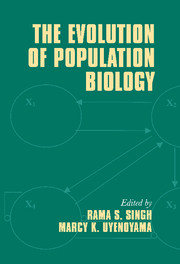Book contents
- Frontmatter
- Contents
- List of contributors
- Publications of R. C. Lewontin
- Preface
- Introduction
- Part I Historical foundations and perspectives
- Part II Genotypes to phenotypes: new genetic and bioinformatic advances
- Part III Phenotypes to fitness: genetics and ecology of populations
- 7 Density-dependent selection
- 8 Nonsynonymous polymorphisms and frequency-dependent selection
- 9 Why k = 4Nus is silly
- 10 Inferences about the structure and history of populations: coalescents and intraspecific phylogeography
- 11 The population genetics of life-history evolution
- 12 Gene–environment complexities: what is interesting to measure and to model?
- 13 Genus–specific diversification of mating types
- Part IV Genes, organisms, and environment: evolutionary case studies
- Part V Applied population biology: biodiversity and food, disease, and health
- Index
12 - Gene–environment complexities: what is interesting to measure and to model?
Published online by Cambridge University Press: 08 January 2010
- Frontmatter
- Contents
- List of contributors
- Publications of R. C. Lewontin
- Preface
- Introduction
- Part I Historical foundations and perspectives
- Part II Genotypes to phenotypes: new genetic and bioinformatic advances
- Part III Phenotypes to fitness: genetics and ecology of populations
- 7 Density-dependent selection
- 8 Nonsynonymous polymorphisms and frequency-dependent selection
- 9 Why k = 4Nus is silly
- 10 Inferences about the structure and history of populations: coalescents and intraspecific phylogeography
- 11 The population genetics of life-history evolution
- 12 Gene–environment complexities: what is interesting to measure and to model?
- 13 Genus–specific diversification of mating types
- Part IV Genes, organisms, and environment: evolutionary case studies
- Part V Applied population biology: biodiversity and food, disease, and health
- Index
Summary
Preamble – 1974
The year 1974 saw the publication of two influential works by Richard Lewontin. In different ways both addressed the measurement and characterization of genetic variation and asked whether the resulting knowledge is interesting – what can we explain or do with it?
The Genetic Basis of Evolutionary Change (1974a) was firmly positioned within the population genetic tradition of viewing evolution as a change of gene frequencies in a population over time. In this light it was obviously important to characterize the amount of genetic variation and account for its maintenance. Lewontin's book masterfully synthesized research on genetic diversity in laboratory and natural populations in relation to models of selection or its absence. At the same time he drew attention to some troublesome themes for evolutionary biology. It was not variation as such that should count, but variation that resulted in differential fitness among the variants. Yet measurements of the components of fitness – survival and reproduction – were possible only when the phenotypic effect of a single allelic substitution was large, not when the effects of gene substitutions made only small differences. This led Lewontin to remark that: “What we can measure is by definition uninteresting and what we are interested in is by definition unmeasurable” (Lewontin 1974a, p. 23).
- Type
- Chapter
- Information
- The Evolution of Population Biology , pp. 233 - 253Publisher: Cambridge University PressPrint publication year: 2004



